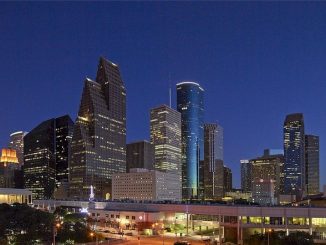
The Chronicle‘s Mike Snyder reported on Wednesday that a revision to the archaic codes used by Mayor White to curry favor with powerful supporters and block the Ashby highrise development could conflict with the city’s new transit corridors ordinance, which is being presented by supporters/media as a code to foster pedestrian-friendly development (but in reality represents a significant power grab).
One of the most important quotes in the story comes nearly at the end:
Chapter 15 was added to the design manual in the aftermath of the Ashby controversy, but it simply put into writing procedures that the city already followed, said Andy Icken, deputy director of the Department of Public Works and Engineering.
Icken said he will work with Marlene Gafrick, Houston’s planning and development director, to add language to the transit corridors ordinance clarifying that reduced automobile traffic is likely along corridors where people will be riding trains. That should reduce the need for any traffic mitigation, Icken said.
In other words, a city official who is supposed to be analytical/nonpolitical has just offered up a very helpful political solution to a problem created by the last very helpful political solution.
Leaving aside that element of The Houston Way, we do wish to highlight what city officials are generally loath to admit to the public: Reduced automobile traffic is likely along corridors where people will be riding trains.
Not only is it likely, but the tremendous impact of laying many miles of new light rail down busy streets (in downtown and uptown) — in the form of greatly reduced traffic mobility — is one of the great undercovered stories in Houston at the moment. Covering the story is not made all that easy by METRO, city planners, or even management districts (which exist to promote and protect the interests of businesses and people that live/work/reside within those districts), as documents can be difficult to obtain and difficult to reconcile with each other. So local media have largely stuck with easier fare, like bunnies and Safety Lou.
We decided it might be useful to reproduce some info from the relevant documents we have been able to obtain and/or review. We have focused only on downtown mobility issues here, although a preliminary review indicates that LOS problems and METRO mitigation “solutions” are even more shocking in the Uptown corridor.
Downtown LRT Impact: The Supplemental Final Environmental Impact Study
METRO’s Supplemental Final Environmental Impact Study was required when the agency decided to switch back to light rail from bus rapid transit on the southeast (downtown) line. We would encourage interested readers to click the following link to read more details about downtown mobility in the 23 pages of Chapter Four (the transportation impact section). Despite the loss of lanes, the signal modifications required, and the crossing of another rail line (and the technical challenges that poses), the METRO forecast projects no real decline in traffic mobility downtown:
Impacts on Level of Service at Intersections
Levels of service at signalized intersections during the a.m. and p.m. peak hours in 2025 were identified for the No Build Alternative and the LPA. The analysis was based on the revised traffic signalized operations needed to accommodate the transit vehicle movements through intersection crossings and modified intersection geometrics as shown on the plan drawings contained in Volume 2 of this SFEIS. The results of the analysis are discussed below.
The level of service analysis for the signalized intersections on Capitol and Rusk assumes that the LRT vehicles would operate through the intersections in reserved lanes parallel to the adjacent through traffic. The results indicate that overall intersection levels of service at most intersections on Capitol and Rusk would remain similar to those conditions identified under the No Build alternative. This is a result of the similar operations at intersections under the No Build Alternative, and the LPA. The results of the level of service analysis for intersections outside of downtown under the LPA indicates that all of the intersections are expected to operate with acceptable overall levels of service during both the a.m. and p.m. peak hours. (SFEIS, Summary, 16, emphasis added)
Just for fun, we’ve reproduced a list of the modifications along the route, also included in the Summary:
Non-signalized Intersection Impacts
Location of the fixed guideway in the median of the roadway would restrict left-turn and through movements at non-signalized intersections. Under the LPA, localized impacts are anticipated at 21 non-signalized intersections. Traffic that currently makes these leftturn movements would need to divert to adjacent signalized intersections. While this diversion of traffic is not anticipated to be substantial, the diverted traffic volumes have been accounted for in the analysis. In addition, pedestrian movements across the median at these intersections would be prohibited.
Signalized Intersection Impacts
Under the LPA, the following signalized intersections improvements would be required:
• At six existing signalized intersections, left turns would be accommodated across the fixed guideway with a new left-turn signal phase that would operate as a protected only phase.
• Six new traffic signals with protected left-turn movements would be required.
• Four other existing signalized intersections would require traffic control modifications to accommodate the fixed guideway at the intersection.
• The modification of the streets to accommodate the fixed guideway would also result in five new non-intersection guideway crossings. Traffic signals and/or flashing light and automatic gate control would be required at each of these nonintersection crossings.The intersection improvements under the other build alternatives would affect up to 13 existing signalized intersections with new left-turn signal phases, nine new traffic signals with protected left-turn movements, nine with traffic control modifications, and five intersections new non-intersection guideway crossings.
[snip]
Mitigation Measures
Mitigation measures for impacts on signalized intersections have been identified and included in the traffic design and signal operations for the LPA. The measures to be implemented at signalized intersections include the following:
• A corridor-wide 90-second cycle length;
• Optimized signal timing splits at each intersection;
• A corridor-wide interconnected coordinated traffic signal system;
• New traffic signal controllers, pedestrian controls, and signage at signalized intersections;
• Traffic signal phasing operations with a special fixed guideway vehicle phase;
• Protected left turn phases for traffic turning across the fixed guideway from parallel lanes; and
• METRO Police would continue to coordinate with state and local authorities on public safety and traffic within the corridor. Educational programs to alert the traveling public of the presence of new transit vehicles will be conducted in the corridor. (SFEIS, Summary, 15-16)
Even more detail on these extensive mitigation efforts that will allegedly result in no real decline in LOS can be found in the full Section Four of the SFEIS, although we feel obligated at least to reproduce the following:
4.4 Parking Impacts
Construction of the LPA would require the removal of both on- and off-street parking. This section identifies the location of parking to be eliminated, anticipated impacts of the elimination of this parking, and mitigation to be implemented, where feasible, for replacement of parking. The No Build Alternative would have no impact to parking.
4.4.1 Removal of Off-Street Parking
Off-street parking consists of designated parking spaces on property adjacent to the LPA. Off-street parking may be provided for customer usage to support businesses or for residences. No for-fee parking facilities would be affected. (SFEIS, 4-21)
Perhaps no parking spots will have to be removed from the parking garages (which are not free), but the claim that they will not be “affected” by long trains that block the facility every six minutes seems a stretch on its face. At peak times and during events, it is hard to imagine that access (to/from) will not be impaired significantly.
Downtown LRT Impact: Reconciling with The Final Environmental Impact Study
The Final Environmental Impact Study was produced after METRO decided to substitute Bus Rapid Transit for Light Rail, and interesting parts of the document clearly reflect an effort to “sell” BRT versus LRT. The Transportation Impacts chapter is 33 pages, some ten pages longer than the Supplemental EIS referenced above.
The following is perhaps the most interesting note on traffic in the whole document:
In the downtown area, traffic volumes would be impacted under the LRT Alternative along Capitol because of the reduction in the number of travel lanes along the roadway. Along Capitol, 40 percent of the westbound through traffic is expected to divert to adjacent roadways. Twenty percent (half of the diverted traffic) is expected to divert north and travel west along Prairie through the downtown segment. The other 20 percent (half of the diverted traffic) is expected to divert south and travel west along Walker to continue travel through downtown. It is also expected that 40 percent of the vehicles that would make turning movements onto Capitol from the northbound and southbound cross streets would also be diverted to Prairie and Walker. Twenty percent (half of the diverted traffic) is expected to turn at the westbound street prior to Capitol. The other 20 percent (half of the diverted traffic) is expected to travel through the Capitol intersection and turn at the next westbound street.
Traffic volumes in the downtown area would not be impacted under the LPA and the BRT alternatives with the alignment on Capitol and Rusk. (FEIS, 4-5 – 4-6)
In other words, in the effort to “sell” BRT in this traffic impact study, METRO claims the LRT option would have a negative impact on downtown traffic of between 20-40% in the corridor. We could not find this reference/admission in the “Supplemental” document referenced previously (which is “selling” LRT).
Here are other modifications required by the LRT option that, according to this report, will cause significant reduction of traffic capacity (but are de-emphasized or cut in the Supplemental report):
Build Alternatives
LRT Alternative between Bagby and St. Emanuel
The proposed fixed-guideway alignment in downtown under the LRT Alternative would begin at mid-block on Capitol between Bagby and Smith. Capitol is a one-way westbound street in downtown. The LRT alignment would be located in the center of the street with one lane of traffic on each side of the alignment. At Travis the alignment would transition to the south side of the street and continue to St. Emanuel.
To accommodate the in-street LRT alignment, the number of through traffic lanes on Capitol would be reduced in some blocks. Between Bagby and Travis, where the LRT alignment would be in the center of the street, the number of lanes would be reduced to one lane on each side of the fixed guideway. At the transition to the south side of the street in the block between Milam and Travis, one lane would be maintained on the north side of the alignment. East of Travis, the trackway alignment would continue on the south side of the street, with two lanes north of the alignment from Travis to Austin and three lanes from Austin to Chartres. East of Chartres, two lanes would be maintained north of the alignment. Left turns would be restricted at most signalized intersections along Capitol in downtown. (FEIS, 4-8 – 4-9)
and
Build Alternatives
Downtown LRT Alternative between Bagby and St. Emanuel
Capacity impacts would occur at a number of downtown intersections along the LRT alignment where there would be no separate lanes for turns across the LRT trackway from parallel lanes. In order to allow the LRT vehicles and through traffic on those roadways to move on the same signal phase, left turns across the LRT trackway would be prohibited at most signalized ntersections on Capitol and diverted to other roadways. The intersections on Capitol where currently legal left turns onto cross streets would be prohibited include Brazos, Smith, Milam, Main, Fannin, Caroline, La Branch, Jackson, Avenida de las Americas, Chenevert, Hamilton, Chartres, St. Emanuel, Hutchins, Bastrop, Dowling, St. Charles, and Live Oak. (FEIS, 4-13 – 4-14)
Despite the reductions in capacity and resulting diversions that are expected, METRO’s predictions for LOS at various intersections remain as cheerily optimistic in this report as in the SFEIS (no real reduction of LOS at downtown intersections).
The issue of parking does make a token appearance in this report, again apparently in the context of trying to boost BRT versus LRT:
The parking impacts under the build alternatives are summarized below by segment:
• Downtown LRT Alternative – In the downtown area, all curb loading zones and on-street parking along Capitol would be eliminated under the LRT Alternative. The reduction in the number of travel lanes along Capitol and the location of the LRT trackway along the south curb from Travis to the east would require the elimination of loading and parking zones to reduce interference with the through traffic lanes. The elimination of the on-street parking along Capitol would eliminate the existing parking meters and associated revenue from the existing parking space utilization. Existing parking garage access and loading dock driveways connecting to Capitol would need to be accommodated across the LRT trackway in areas where the adjacent travel lane has been eliminated. (FEIS, 4-32)
Downtown LRT Impact: Two More Studies
A report entitled “2012 Downtown LRT Traffic Analysis” with a date of September 2008 was prepared for METRO Solutions by Kimley-Horn and Associates (we are not able to reproduce this report, and instead rely on our own transcriptions of the same). Their analysis made a number of key assumptions:
Buildings were assumed to be 80% occupied in year 2012. A 30% trip reduction factor was applied to the 80% occupancy to account for being located within a central business district and having access to transit facilities…. (E-1)
The analysis further assumed LRT headways of 6 minutes during morning and evening peak hours. Kimley-Horn offered the following conclusion:
Most intersections within the study area Downtown operated at an acceptable LOS for both Case Study #1 and Case Study #2.
[snip]
[T]he primary conclusion that can be drawn from the VISSIM results is that both case studies can operate in an acceptable manner in 2012, based on overall peak hour assessments of traffic operations within the Downtown study area. To conclude that this study has solved all intersection LOS issues, preemption locations, driveway hazards, signal timing issues, and train operations would be misleading (23 – 24)
One notable part of their report contained additional parking that is expected downtown by 2012, including: Discovery Tower (some 1,450 spots), Houston Center Six Crescent (some 1,575 spots), North Tower Hines (1,050 spots), Kimberly Clark (unknown), Main Place (1,104 spots), La Quinta (unknown), and a proposed convention hotel (unknown).
The study notes that all driveways and loading docks were not studied.
We have seen a second study/memo, “Peer Review of 2012 Downtown LRT Traffic Analysis, Kimley-Horn and Associates dated September 2008,” that was prepared by the Texas Transportation Institute for the Houston Downtown Management District. Here are a number of interesting observations from that memo:
While the VISSIM model used for this analysis included vehicle traffic (and traffic signal control), LRT traffic (and control), and bus traffic (including within preferential lanes), it did not include pedestrian traffic, which may have significant impacts on vehicle and bus operations and delay. (2)
Pedestrians, downtown? Surely not!
Finally, we have seen another memo from the Texas Transportation Institute (dated March 2009) to the Downtown Management District that reviews a followup Kimley-Horn study (which we have not seen). Here are some ominous observations from that memo:
The 2035 modeling effort did include pedestrian traffic…. It appears that pedestrian LOS will be acceptable, but that there is chance that vehicular LOS may be LOS E or F in some cases during the peak hours. (8)
and
I believe that the key will be continued communication between METRO, City of Houston, and the Downtown District so that all parties are aware of current and future plans and changes in operational plans once they are being considered (not once they are to be placed in operation). (9)
Notice the one interested party that is neglected in this important discussion? The general public. Unfortunately, it’s not very easy for the general public to get their hands on these documents, METRO hasn’t shown much interest in publishing these particular documents, and the local media hasn’t shown much interest in obtaining them, analyzing them, and posting them for public review.
Downtown LRT Impact: The Parsons contract
One of the more interesting — and certainly more detailed — sets of documents on downtown mobility is the contract between METRO and Parsons Transportation Corp, which spells out alignments and design specifications (as determined at this point) and scope of work and such.
Here’s a bit of news regarding the coming light rail construction that most downtowners probably haven’t seen:
4B.5.1 Bridges
[snip]
Tranquility Park Parking Garage Bridges (Three)
The area of Capitol and Rusk and Bagby Intersection if a four level deep parking garage. It will be necessary to reconfigure and reinforce/upgrade the capacity of these structures to handle the LRT loading and geometry. Replacement of entire portions of the structures will be considered as a last resort. The modifications to these bridges are conceptual in nature.
Downtown Corridor Tunnel Bridges
At multiple locations in the downtown corridor we will be required to place the guideway over tunnels between the downtown buildings. It may be necessary to reconfigure and reinforce/upgrade the capacity of these structures to handle the LRT loading and geometry. Replacement of entire portions of the structures will be considered as a last resort. (Basis of Design Report, 255)
How many tons do the light rail cars weigh? Quite a bit, which almost certainly means massive, intrusive reconstruction. This ought to be fun for the folks who work downtown and use the tunnels!
And this stark admission could blow up all the rosy assertions about LOS in the corridor:
Train Operating Speeds for Streets along the Corridor:
- Texas Avenue – St. Emmanuel Street to Dowling Street – 35 MPH
- Downtown – Train Operating Speed in Downtown to match existing vehicular traffic speed (may not be able to maintain planned 6-minute and 12-minute headways) (Basis of Design Report, 251)
A small reduction in those six-minute headways, combined with existing congestion from traffic, pedestrians, AND the Main Street line (see below) could have a significant impact on LOS downtown, potentially producing gridlock and/or killing vehicular traffic as drivers decide parts of downtown just aren’t worth the hassle.
Likely LRT Impact: The Main Street example / Conclusion
As we noted at the beginning, we concur with Mr. Icken on the likely impact of at-grade LRT on traffic mobility — especially downtown. We think that impact will be severe and will lead to traffic gridlock initially, declining traffic overall as drivers seek to avoid the mess, and dangerous situations for drivers, pedestrians, and trains alike. But who cares what we “think?” We already have evidence in a corridor with much less traffic that suggests at-grade rail will lead to more accidents (hence the nickname Danger Train). And Tom Bazan took the time to compile intersection traffic reports along the Main Street line that demonstrate up to 84% declines in car traffic at some intersections along the Main Street line.
For those who don’t want to take Tom Bazan’s compilation seriously though, we can just turn to the recent Booz-Allen-Hamilton performance audit of METRO, which noted that reducing the Main Street line’s current headway of six minutes (during peak times) only slightly would cause “street gridlock.” This is an audit of the current rail system, and does not take into account the problems that will be introduced when multiple segments of new light rail lines cross the Main Street line at busy points downtown (for intrepid souls who want some homework, scan the documents we’ve linked for references “interlining”). Indeed, we would suggest that the current rosy traffic mobility predictions don’t properly account for those problems either.
In short, it’s hard to square the rosy assumptions in some public METRO documents with the more serious concerns about mobility that are documented in other places. And it’s even harder to understand the disinterest exhibited by many members of the local media, elected officials, and district management stakeholders in letting the public in on what is about to happen.




